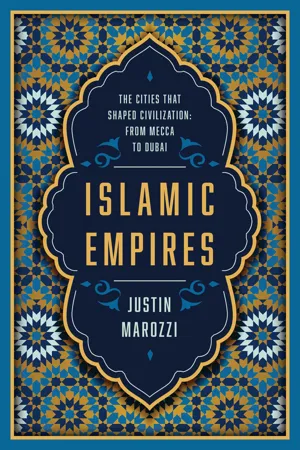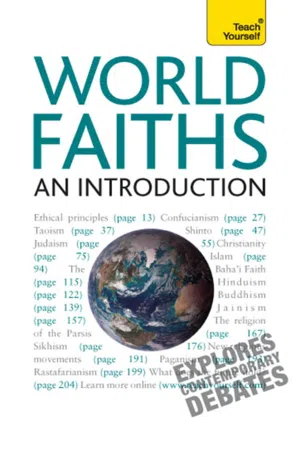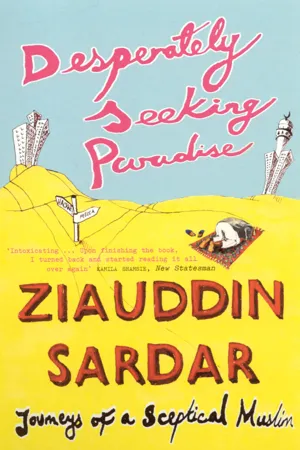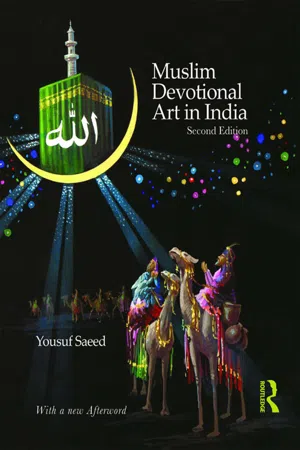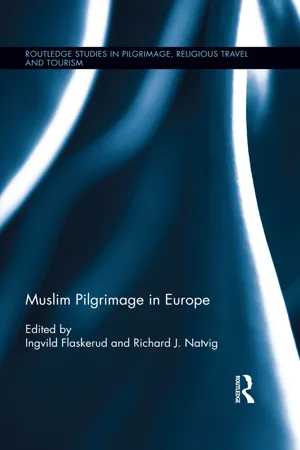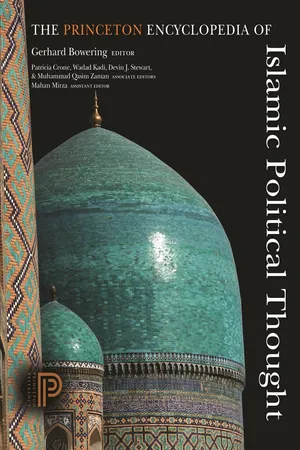History
Mecca
Mecca is a city in Saudi Arabia that holds great religious significance for Muslims. It is the birthplace of the Prophet Muhammad and the site of the Kaaba, the most sacred structure in Islam. Muslims around the world face towards Mecca when performing their daily prayers, and the city is the focal point of the annual Hajj pilgrimage.
Written by Perlego with AI-assistance
Related key terms
7 Key excerpts on "Mecca"
- eBook - ePub
- Justin Marozzi(Author)
- 2020(Publication Date)
- Pegasus Books(Publisher)
1 Mecca – Mother of All Cities (7th Century)Many a time have We seen you turn your face towards the sky. We will make you turn towards a qiblah that will please you. * Turn your face towards the Holy Mosque; wherever you be, turn your faces towards it.Quran 2:144For centuries Mecca has been a mostly intangible aspiration. It haunts the imaginations of the great majority of Muslims unable to complete the arduous, often dangerous and invariably expensive hajj pilgrimage. Those fortunate enough to have made the journey frequently consider the hajj the most spiritually satisfying experience of their lives. They return describing it in hallowed tones, recalling pounding hearts, quickening pulses and flowing tears, using words like ‘mind-blowing’, ‘mesmerizing’ and ‘humbling’. To a man and woman, each pilgrim is overwhelmed by an emotionally charged experience in a gathering of humanity without parallel in history.The city of the Prophet Mohammed’s birth has always drawn its potency for Muslims from both the story of his God-given revelations there in the seventh century and the totemic status of the Kaaba, the cube of black granite which is considered the House of God, at the heart of the pilgrimage. All Muslims who were physically and financially able to do so were required by the Quran to perform the hajj to Mecca, the only place in the world where such a visit was obligatory. The subsequent centuries of tradition and pilgrimage have only added greater brilliance to the city’s unique lustre within the Islamic world. Mecca is the immutable and undisputed centre of Islam, the lodestar to which the world’s Muslims direct their prayers; the Kaaba the single point on the planet around which pilgrims literally revolve.Today a clock tower rears 600 metres above the Kaaba, completely dwarfing the sacred monument that inspired its erection. Were a pigeon to leave its seed-hunting colleagues at ground level for a few minutes and flutter up to these dizzying heights, it would stare down to the north at what might be taken for a vast sports stadium teeming with white-robed fans moving in procession around a rectangular object. Yet this is no sports arena. The Abraj Al Bait, or Makkah Royal Clock Tower, a skyscraper complex of luxury hotels, apartments and shopping malls, complete with heliports, jacuzzis, saunas, steam rooms, chocolate rooms, beauty parlours, business centres, ballrooms and twenty-four-hour butler service, looms over Islam’s holiest mosque, the Masjid al Haram, or Sacred Mosque, and the cube at its heart, the Kaaba. Once a year, in the world’s greatest display of organized religion, a swirl of humanity circumambulates seven times around this thirteen-metre high stone block, directing its collective prayers to the Almighty. - eBook - ePub
- Paul Oliver(Author)
- 2010(Publication Date)
- Teach Yourself(Publisher)
Kaaba , which housed among others things symbols of the divinities of Arabia. People traditionally made pilgrimages to Mecca to see the Kaaba and this large number of regular visitors to the city inevitably increased the economic prosperity of the Quraysh. Arabia could legitimately be described as a polytheistic society, although tribal mores and morality were arguably a more potent force than religion.Muhammad received a series of spiritual revelations from God and these formed the religious basis of Islam. In the early days of the development of Islam, some people were opposed to the new faith, but Muhammad managed to place the faith upon firm foundations in his lifetime. Muhammad was born in Mecca in 570 CE as a member of the Hashim clan and his early life was not easy. Muhammad’s father died before his son was born and Muhammad’s mother died when he was six years old. This must have been difficult for the young boy, even though he did have the support of an extended family. Muhammad was cared for initially by his grandfather and then by an uncle, Abu Talib. It seems probable that Abu Talib sought to teach Muhammad the skills of adulthood by taking him on trading journeys by caravan, and on one occasion it is likely that Muhammad went on a journey to Syria.Probably because of his developing skills in trade, a widow named Khadija asked Muhammad to manage one of her caravans for her. She was a woman of considerable wealth and also experienced in matters of commerce and trade. Muhammad proved to be extremely capable and although there was an age difference between them (Khadija being about 40 years old and Muhammad about 25) they married. According to tradition, Khadija bore seven children to Muhammad, although three of them died when very young. Muhammad gradually grew more and more respected in Meccan society, not merely because of his success in business, but also because he was recognized as being scrupulously honest in his dealings with people. - eBook - ePub
Pilgrimage
Journeys of Meaning
- Peter Stanford(Author)
- 2021(Publication Date)
- Thames and Hudson Ltd(Publisher)
CHAPTER 4Mecca
A WORLD APART
‘Our notions of Mecca must be drawn from the Arabians; as no unbeliever is permitted to enter the city, our travellers are silent.’EDWARD GIBBON ,THE HISTORY OF THE DECLINE AND FALL OF THE ROMAN EMPIRE(1776–89)A Mecca draws people to it because it does what it does better than anywhere else. The expression was first used in English in this way in the nineteenth century. An 1826 article in the doctors’ journal The Lancet describes the medical schools of Scotland as ‘a Mecca for the studious’. Nowadays it is readily and repeatedly applied to anything from shopping malls to ski slopes and surfer beaches. The origin is, of course, Mecca, the holiest city in Islam, visited each year by up to four million pilgrims, but while its name has been widely appropriated, Mecca itself is not a Mecca for all modern-day pilgrims. Entry remains, as it has been since the earliest days of Islam in the seventh century CE , restricted only to Muslims. The new generation of unaffiliated pilgrims, for now, is not welcome.One of the very few non-Muslims to have experienced Mecca during hajj , the high point of its year, was the British traveller Sir Richard Burton in 1853. Back then, there were none of the visa controls and checkpoints into the city that currently filter out non-Muslim pilgrims, so with the unstoppable curiosity of the Victorian explorer determined to ‘open up’ the world, he set out to circumvent what barriers did exist. He was resolved, he wrote, on ‘removing the opprobrium to modern adventure, the huge white blot which in our maps still notes the Eastern and Central regions of Arabia’.1Burton slipped unnoticed into Mecca by donning a disguise that allowed him to blend in with a party of visiting Pathans, Afghan Muslims, whom he had first encountered and befriended when serving as a British army officer in India. He had journeyed overland with them, in the traditional manner of pilgrims, with the Egyptian capital Cairo as a major gathering point. Some Muslims who congregated there would have walked all the way from the west coast of Africa, taking several years and living as they journeyed as nomads. Burton’s group then crossed Sinai, where they joined others travelling from points further north on the darb-al-hajj, the principal route that heads south through the Arabian Desert to, first, Medina (where the Prophet Muhammad is buried) and then Mecca. Tracing its origins as far back as the Iron Age, this road had been established in the fourth century BCE for trading and religious reasons by the Nabatean kings (they, too, regarded Mecca as a holy place, and worshipped their deities there). It was then upgraded by the all-conquering Romans, who renamed it the Via Nova Triana. In the early years of the sixteenth century, with the expansion of the Ottoman Empire to include Mecca, it continued to be a major artery for officials, armies, merchants and the pilgrimages that were waved off with great ceremony from Constantinople for hajj - eBook - ePub
Desperately Seeking Paradise
Journeys of a Sceptical Muslim
- Ziauddin Sardar(Author)
- 2012(Publication Date)
- Granta Books(Publisher)
I started working at the Hajj Research Centre with great relish. Mecca is the light that still remains with me, the shimmering, flawless light that illumines the still point to which all Muslims turn. It is what I remember most of my first visit to the Haramain, the sacred precincts at the heart of Mecca. Mecca, the birthplace of Muhammad, the site of the Holy Kaa’ba, is the prime focus of the Muslim world. The profound intensity of the moment burst upon me as I stepped out from the colonnaded mosque into the great open space surrounding the Kaa’ba. A little voice within me, overpowered and amazed, whispered ‘I am here.’ Before me was the great cube-shaped building, draped in black cloth edged with gold embroidered calligraphy: the Kaa’ba. No image more familiar, no location better known, no direction more sought-after exists for any Muslim anywhere at any time. I was here. The Kaa’ba stood silent and still. I could hardly breathe as I walked out into the pool of light and radiant heat; I felt as if every butterfly everywhere was flapping its wings and I was wafted along on the updraught. I moved, unconscious of my movement, to make the journey seven times around the Kaa’ba. In that heart of light I was enfolded in what it is to be me, what it is to be a Muslim. One can live with the awe of that moment far better than one can describe or communicate it.The Kaa’ba is the pre-eminent symbol of Islam. It is a house of worship of The God, believed to have been built and dedicated for this purpose by Prophet Abraham. Events in the life of this Patriarch of Judaism, Christianity and Islam underpin and define the traditional rituals of being in Mecca. This fixed point provides Muslims with their sense of direction: five times a day, the faithful turn to face not only Mecca but the Kaa’ba within Mecca, when they pray. From every point on earth a Muslim seeks an orientation towards this central place, the starting point of dedication to The God and his guidance of values and ethics, to which they must constantly return on the daily journey through life. It is also the ultimate goal, the embodiment of the spiritual objective to hold a constant course through the vagaries of life’s trials and tribulations. It is a definite, finite goal of spiritual endeavour since every Muslim, once in their lifetime, if they can afford it, is required to perform the Hajj, the pilgrimage to Mecca, when they will each take that walk seven times around the Kaa’ba, united in awe, humbled by the experience. - eBook - ePub
- Yousuf Saeed(Author)
- 2018(Publication Date)
- Routledge India(Publisher)
Chapter 1 The Image of Mecca in IndiaThe most common icons found in almost every Muslim household are the images of two famed Arab shrines, the Ka’ba, a cubical structure draped in black and situated in Mecca, and the Gumbad-e khizra, the green dome in Medina over the mausoleum of Prophet Muhammad (peace be upon Him) (Fig. 1.1 ). Although one is not supposed to worship them or their images, the reverence for and the desire to make a ziyārat (pilgrimage) to them is strongly instilled in the mind of every believing Muslim. Even qibla , the direction to Mecca, acquires a centrality in a Muslim’s daily life. Besides offering the customary five-times-a-day namāz (prayers) strictly facing the Ka’ba, some Muslims even find it disrespectful to lie down with their feet towards it. Frequent mentions of Mecca and Medina, along with the seerah (biography) of Prophet Muhammad and Islam’s early history, remain an integral part of every Muslim’s upbringing. These have also been referred to in much of devotional Islamic literature, in prose and poetry, in countless vernacular languages. Thus, for an Indian or a non-Arab Muslim, situated thousands of miles from these holy shrines that he or she may probably never see in real life unless fortunate enough to make a pilgrimage, simply gazing at the images of the Ka’ba and Medina fills an ocular void and further arouses the desire to visit them.The Hajj became obligatory for Muslims at the time of Prophet Muhammad in 632 AD, although the Ka’ba had existed as a centre of pilgrimage and prayers for many centuries before the advent of Islam. Some Muslims believe it was originally built by Adam, the first Prophet, although it later got destroyed in the great flood at the time of Noah. The existing shrine, it is believed, was constructed or renovated by Prophet Abraham (early 2nd millennium BC) when he came to settle in the region after being driven out from Iraq, Syria and Palestine for practising and preaching his new faith. Following this, Mecca became a great centre of pilgrimage and trade, attracting thousands of pilgrims from in and around Arabia. Many existing rituals and sacred sites of the Hajj pilgrimage still reflect events from the life of Abraham, his wife Hajira (Hager) and son Ismail (Ishmael), including the miraculous springing of the water-well called Zamzam1 - eBook - ePub
- Ingvild Flaskerud, Richard J. Natvig(Authors)
- 2017(Publication Date)
- Routledge(Publisher)
Summing up the various rites that make up the hajj, it can be concluded that the pilgrimage is an extremely powerful ‘sensational form’: a relatively fixed, authorized mode of invoking and organizing access to the transcendental (Meijer 2012). Islamic cosmology is translated through the kinaesthetic appropriation of the Meccan landscape; pilgrims incorporate the moral lessons behind the stories related to the various hajj sites through bodily and mental exercises rather than through disembodied belief (cf. Mitchell 2001). This ‘sensational power’ of the hajj provides a first answer to the question what it is that triggers such emotional responses in Muslims who visited the hajj exhibition: these responses are related to a longing for Mecca as the place where proximity to God, the Prophet Muhammad and other Islamic role models can be experienced in a most direct way.A general feature of rituals that include commemoration of the past is that claims to continuity play a significant role in shaping relations and boundaries between past and present and between external and internal communities (Connerton 1989, 48). A second factor that contributes to the appeal of Mecca for Muslims, then, is that the flow of pilgrims circumambulating the Ka‘ba is the most powerful symbol of the ideal of the umma : the global Muslim community created by the Prophet Muhammed.2 While the unity of the umma has always been of great significance for Muslims, in the next section I will argue that it has gained more salience in today’s era of globalization, particularly for European Muslims with migration backgrounds.The hajj and homecoming
That so many Muslims visited the Dutch hajj exhibition illustrates the popularity of Mecca. Indeed, decorating one’s home with images of the Ka‘ba has a long history (cf. Porter 2015). The presence of such images in both private and public Muslim spaces has increased tremendously with the introduction of photography and, more recently, the new media. Mecca features on Muslim television stations on a near daily basis, for instance.3 - Gerhard Bowering, Patricia Crone, Wadad Kadi, Devin J. Stewart, Muhammad Qasim Zaman, Mahan Mirza, Gerhard Bowering, Patricia Crone, Wadad Kadi, Devin J. Stewart, Muhammad Qasim Zaman, Mahan Mirza, Gerhard Bowering, Patricia Crone, Wadad Kadi, Devin Stewart, Muhammad Zaman, Mahan Mirza(Authors)
- 2012(Publication Date)
- Princeton University Press(Publisher)
ḥanīf , the monotheist who had rejected all pagan polytheism. He now maintained that Abraham, assisted by his son Isma‘il, had erected the Ka‘ba (Q. 2:127) and celebrated the rites there that Muhammad sought to restore to their original purity.Distancing himself somewhat from his identity as a prophet called to warn people of an oncoming apocalyptic judgment and to confirm the revelations other groups of people had received in their own languages before him, Muhammad now embraced his new role as legislator and leader of the burgeoning Muslim community. It now became the duty of his followers to obey God and the Prophet. He pursued his newfound role not only in Medina but also in his relations with the Meccans, who constituted the major challenge he faced outside Medina. With Mecca as the focus of his religious thrust and with the responsibility of providing sustenance for his group of emigrants, Muhammad turned his attention to Mecca and focused the energies of the Arab tribesmen who were accustomed to raiding. His altercations with the Meccans, developing from skirmishes to full-fledged war, were driven by the idea of jihad, the all-out struggle on the path of God that demanded the total devotion of his Muslim followers such that they would go to war against the Quraysh of Mecca.A new chapter began in the life of Muhammad and that of his community with a sequence of battles with the Meccans. A first instance of war was triggered by a raid made by some of Muhammad’s followers on a caravan at the oasis of Nakhla. In it a Meccan was killed during the holy month of Rajab, in which raiding was forbidden by current pre-Islamic custom, and the spoils of his operations were taken to Medina. Emboldened by this success, Muhammad led a group of his Medinan followers in a new raid on a caravan of the Quraysh that was advancing from Syria to Mecca. In their attempt to ambush the caravan at Badr in 624, Muhammad’s small contingent was forced to engage an army sent from Mecca to protect the caravan (Q. 3:123); surprisingly, however, they succeeded in routing the superior enemy, whose leader Abu Jahl was slain. Muhammad interpreted his glorious victory as divine confirmation of his religion and believed that angels fought at his side, enabling him to overpower the forces of the mighty commercial hub of Arabia. Islamic historiography upholds this day as a great watershed in the course of Muslim ascendancy as granted by divine assistance. To follow up on his victory, Muhammad not only expelled the Banu Qaynuqa’ but, more importantly, sent letters to Bedouin tribes to contract alliances of mutual assistance with them, now recognized as a leader well beyond the confines of Medina. Trying to avenge their losses at Badr, the Meccans equipped an army of 3,000 men and sent them against Muhammad’s forces in 625 under the leadership of Abu Sufyan, defeating them decisively at the hill of Uhud outside Medina (Q. 3:118, 121; 33:23). In this battle Muhammad was severely wounded and his uncle Hamza was killed. The Meccans, however, did not follow up on their victory and returned home thinking that they had put the upstart in Medina in his place; for his part, Muhammad expelled the Banu al-Nadir from the town and confiscated their possessions in order to replace the spoils his force had failed to secure in the battle.
Index pages curate the most relevant extracts from our library of academic textbooks. They’ve been created using an in-house natural language model (NLM), each adding context and meaning to key research topics.
